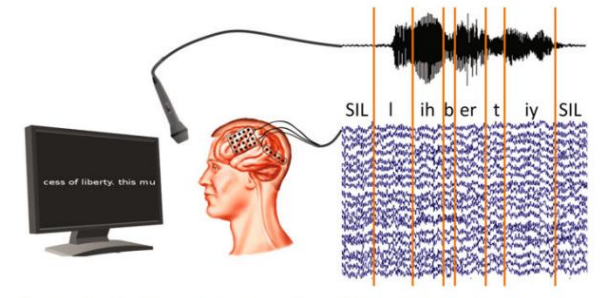Brain-computer interface (BCI) technology was first developed as a tool to provide basic interactions, such as communication, without movement. In the past few years, there has been a shift towards new patient populations and applications, such as helping stroke patients regain movement or helping neurosurgeons map the brain more accurately for faster and safer operations.
Let us consider in more detail the main types of modern brain-computer interfaces. They can be divided into four main groups:
Brain-computer speech interfaces
Motor interfaces
Cyborg control interfaces (microchipping of living organisms)
Rehabilitation interfaces
Speech interfaces
1) ECoG-based BCI based on auditory attention to natural speech
People with severe neurodegenerative diseases (such as advanced amyotrophic lateral sclerosis (ALS)) eventually lose muscle control and can no longer gesture or speak. Recent research suggests that electrocorticographic (ECoG) signals in the gamma range (ie 70-170 Hz) can be used to determine the identity of auditory speech stimuli.
In their work [1], the authors are exploring this possibility by implementing a real-time system based on the BCI2000 that uses ECoG signals to identify the present speaker.
72 . g.HIamp BCI BCI2000, 1200 .

, . () , , , 20% ∶ 80% 80% ∶ 20% , .
. , () , , . , ,
2) -
- () . , . , . , , , . .
7 [2] , (). () . . .

- , , , . , , BioKIT. , .
() , , . . . , .
, . .
, ()
w/ih/aa/r/ /k/aa/m/ih/t/aa/t/ /t/aa/t/eh/
We are commited today

-
- () - - . , , , , .
() . , , .
, , .
8 × 16 20- , . .

- hd-ECoG .
, , . , . , 5- , .
, , , - . , , . , , . , , , , , , , .
( )
[4] . , . -. () (SSVEP) . . , 85%. , 20% .
. 1. SSVEP . SSVEP , , . 12,5, 8,33, 6,818 , , . () , , .

- . , (, , ) . 1,5 , 50 , 50% 500 . , , -.
-. 1,5 . -. - 120- SSVEP. 120- , , . , . : S- .
, -, , 20% S- . - 40%. S- :
, .
- , , , . - , . 2 , .
, . . , (), () . -.

[5] , : - , (. . 3): , , . - . , , , , . 2 .


, , . , .

, , - .

https://link.springer.com/chapter/10.1007/978-3-319-57132-4_2
https://link.springer.com/chapter/10.1007/978-3-319-57132-4_3
https://link.springer.com/chapter/10.1007/978-3-319-57132-4_4
https://link.springer.com/chapter/10.1007/978-3-319-57132-4_6
https://link.springer.com/chapter/10.1007/978-3-319-57132-4_8
http://www.prointellekt.ru/EEG1.php